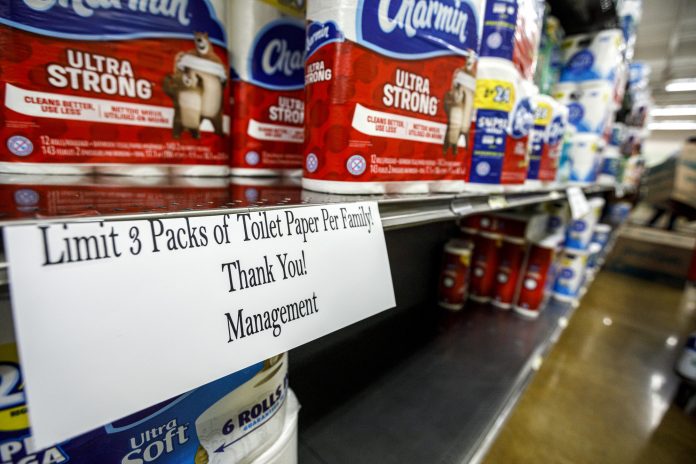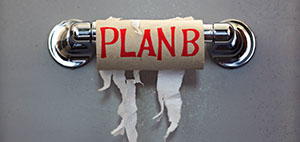

When society collapses and the shelves in the grocery store are empty for an extended period of time, people will still have to use the toilet and that means they will still need toilet paper.
And if it’s not an incident of the end-of-the-world kind, if it’s just a winter storm that delays good delivery for two weeks and you run out of toilet paper, you’ll need to find something to get you through. Fortunately there are homemade toilet paper replacements that you can usually find around your house.
Standard Alternatives
You may be out of toilet paper but you may still have other materials around the house that would fit well as a toilet paper replacement. I am thinking about other products purchased from shop, like:
- Facial tissues (Kleenex)
- Paper towel
- Baby wipes
Just don’t flush these two last choices, as they can block your toilet. But chances are, you’re probably out of these if you’ve run out of toilet paper. So let’s take a look at other options that you can find in and around the house.
Found Around the House
Other than the above-mentioned materials that you can buy at the store and that can replace toilet paper, there are other materials that you could lie around your home that would work too. Here are some recommendations:
- Paper: This may be newspaper, paper for printers, paper for notebooks or any other paper you can find. It’s not as soft as toilet paper but it does the job for sure. Ideal for softening it is to crumple the paper up a lot. Afterwards, the paper you use can be burnt for easy disposal.
- Sponge: A damp sponge may be used for wiping after using the toilet. This was common practice in ancient Rome, where they used to place and clean themselves with a sponge from the end of a stick. Just remember that if the sponge is not properly cleaned, it can easily harbor bacteria, so after each use, it should be soaked in or boiled in bleach water and then rinsed out.
- Water: Whether you have the water indoors or find it outdoors, water will rinse off anything you need to clean. If it’s winter, you can use it in a spray bottle, get a portable bidet, use a hose or get snow. A ball of snow works wonders! When you’re done, you should fill your left hand with water and wash yourself, then wash your hands very well. In many countries where they actually don’t have the luxury of toilet paper, this is what is done.
- Cloth: You probably have all kinds of clothing lying around the house. Perhaps that old nightgowns and PJs, old bedsheets, old towels or some other fabric-made old clothes or materials. When you’re out of toilet paper, cloth is a great alternative and many self-sufficient folks choose to use cloth wipes despite having access to toilet paper. If you need to wash and reuse, you can dampen it, which makes it perfect for the entire family.
Related: Toilet Paper Pills – The Best Invention You Didn’t Know You Need
Found Outdoors
If you don’t have any materials in your home that would work as a toilet paper substitute or you’re caught away from home, then you need to start looking outside.
Luckily, nature has provided us with so many great natural butt wipes that you might be surprised at how easy it is to get around without toilet paper. Check out the options here:
Leaves: Yes, for apparent reasons that’s the obvious option. There are leaves out there, everywhere. They’re big, soft and in plenty of supply. Leaves you can use include:
- Maple
- Mullein
- Large-leaved aster (aka. lumberjack toilet paper)
- Cottonwood
- Hazelnut
- Thimbleberry
- Fuzzy lamb’s ear
- Grape
There are of course plenty of other choices. Knowing the poisonous plants is the most important thing to consider, and avoid them. The last thing you want to do is use poison ivy, poison oak or poison sumac to wipe your sensitive parts! Stay away from the plants in groups of three which have leaves.
- Pine needles: These are really a form of leaf, and yes, after using the toilet, they can be used to clean effectively. Pine needles are not, of course, the softest option, but they do a decent job.
- Moss: That’s a great substitute for toilet paper if you have access to moss. Generally, you can pick up the moss in a chunk and whip it with it. You just have to be careful that while you’re using it the moss doesn’t fall apart.
- Pine cones: Pine cones don’t sound like they’d be very comfortable, but they’re going to do a decent job scraping off everything that needs to be washed up. Plus, they’re no shortage, whether you’re in the city or a rural area.
- Hemp: You will have plenty of substitutes toilet paper if you have access to the hemp plants. Hemp is growing rapidly, and sustainable.
- Corn husks and cobs: only because they grew so much corn in the pioneer days, this was the traditional cleaning element for farmhouses. The husks will be saved and set aside for use as brushes, and taken to the outhouse. They would simply be stored for use in the outhouse, if needed. If they were needed in the winter, they would dry out the corn husks. Many people still used corn husks even after the toilet paper had become available. Corn cobs were also used for toilet cleaning but the husks would be much more comfortable.
- Stones: As strange as this sounds, a flat and smooth (smooth is important!) small- to medium-sized stone can be used to clean after use of the toilet. A stone like this was used by many ancient societies to clean up after toilet use.
Related: Are Baby Wipes the Ultimate Prepping Asset?
How to Make Your Own Toilet Paper


When it comes to toilet paper, who knew there were so many alternatives? But what if you could actually be able to produce your own toilet paper? If you’ve got paper around the house, then you can! Here’s what you ‘d need:
- Any paper, except for glossy magazine paper
- A pot
- Water
- Aloe, baby oil, or any type of unscented lotion (these act as softening agents)
- Witch hazel (optional; acts as an antibacterial agent)
- Grass and leaves
- Rolling pin
- Mallet or hammer
- Sheet or towel
- Ladle or spoon
- Large cutting board or other flat board
Follow these steps to make toilet paper:
- First soak the paper in water to remove as much ink as you can, particularly if you are using newspaper. Once at least 3⁄4 of the ink has sprinkled from the paper you can pull it out of the soak water.
- Place it in a pot with two handfuls of grass and leaves after you soak the paper, and cover it with water. Bring this to a boil and let it cook for one hour at low temperature.
- Hold the water for half an hour to rolling boil. You can add water as needed and you’ll find the foam forms you need to remove at the top.
- The paper is turned pulp after boiling. You must now remove the pot from the heat and drain the water without removing the pulp from the plant. The best way is to scoop most of the hot water out, leave the pulp intact and then let the rest cool down. If the pulp is to be removed from the pot, do not allow it to dry out. When the water is gone you need to put it back in the bowl.
- Once the pulp is put back in the pot, mix in 4 tablespoons of oil or lotion, softening the paper, and just a few drops of witch hazel, if you use it.
- Spread the pulp mixture onto a spreading towel or sheet on a flat hard surface. You can roll it out, getting it as thin as you can with the rolling pin. You should pound these down with the mallet when there are lumps.
- Lay the board atop the rolled out pulp and weight down with heavy objects.
- Take the weights and the board off after 30 minutes. The towel or sheet can then be turned over and pulled off the toilet paper.
- Put the toilet paper out to dry in the sun.
- You can trim it into strips once dry.
Whether you have the time, the ingredients, and the equipment to make your own toilet paper or you want to find a substitute, the fact is that when society collapses or there is an event that disrupts life for a period of time, after using the toilet, you’ll need something to wipe off. After all, when you’re on the SHTF you really never know whether or when you’re going to see store-bought toilet paper again, so you just have to learn how to make your own or find alternatives that work.




















